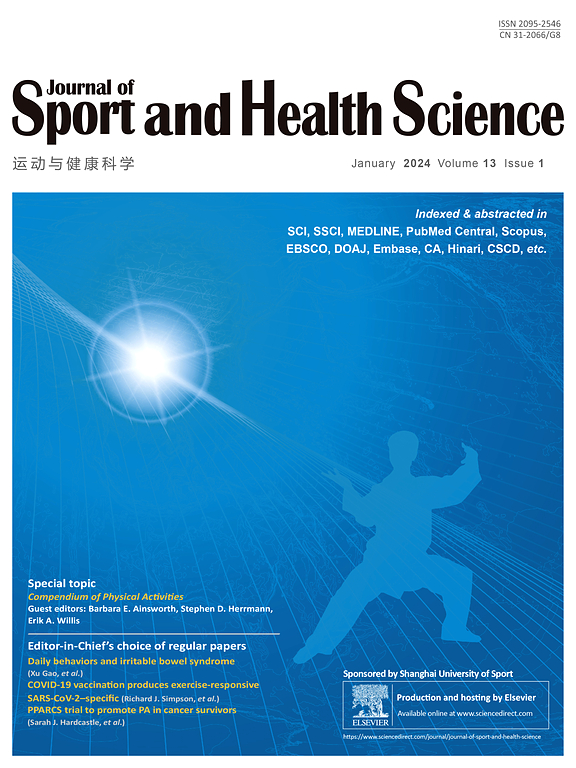使用客观眼动追踪装置测量持续脑震荡后症状的儿童和青少年脑震荡相关视力障碍
IF 10.3
1区 医学
Q1 HOSPITALITY, LEISURE, SPORT & TOURISM
引用次数: 0
摘要
背景:准确识别脑震荡相关视力障碍(crvd)可以通过早期管理、转诊和治疗来改善预后。客观眼动追踪可为crvd的诊断提供额外的数据支持。本研究的目的是确定客观红外眼动追踪在识别受伤后持续脑震荡后症状(PPCS)超过28天的青少年crvd中的应用。方法采用视觉前庭检查(VVE)、综合视力检查和眼动仪对青少年PPCS进行前瞻性研究。结果入组的108名青少年中,67名(62%)通过综合视力检查诊断为CRVD。在VVE上,近会聚点断裂(5.5±3.2 cm (mean±SD) vs. 3.9±1.7 cm, p < 0.001)和恢复(8.1±3.3 cm vs. 6.8±2.3 cm, p = 0.02)区分了有无CRVD患者。水平扫视的VVE震荡症状诱发(35例(52%)vs. 12例(29%),p = 0.02)、水平前庭-眼反射测试(37例(55%)vs. 14例(34%),p = 0.03)、前闭眼条件下串联步态摇摆(25例(37%)vs. 6例(15%),p = 0.01)也可诊断为CRVD。通过眼动仪的BOX评分(8.1±5.8 vs. 5.2±4.1,p = 0.007)和左眼沿视觉目标底部跟踪的指标(0.094±0.500 vs. -0.124±0.410,p = 0.02),通过多变量受者工作特征曲线分析,包括BOX评分,获得受者工作特征曲线下面积为0.7637。结论crvd在PPCS患者中较为常见,对脑震荡后的恢复有影响。新的眼动追踪指标可以帮助识别那些患有crvd的人,他们将从综合诊断和治疗中受益。本文章由计算机程序翻译,如有差异,请以英文原文为准。
Metrics of concussion-related vision disorders among children and adolescents with persisting post-concussive symptoms using an objective eye tracking device.
BACKGROUND
Early identification of concussion-related vision disorders (CRVDs) may improve outcomes by enabling earlier management, referral, and treatment. Objective eye tracking may provide additional data to support the diagnose of CRVDs. The purpose of this study was to determine the utility of objective infrared eye tracking in identifying CRVDs among adolescents experiencing persisting post-concussive symptoms (PPCS) more than 28 days after injury.
METHODS
This was a prospective study of adolescents with PPCS evaluated with visio-vestibular examination (VVE), comprehensive vision examination, and an eye tracking device.
RESULTS
Of the 108 adolescents enrolled, 67 (62%) were diagnosed with a CRVD by comprehensive vision examination. On VVE, the near point of convergence break (5.5 ± 3.2 cm (mean ± SD) vs. 3.9 ± 1.7 cm, p < 0.001) and recovery (8.1 ± 3.3 cm vs. 6.8 ± 2.3 cm, p = 0.02) distinguished between those with and without CRVD. Concussion symptom provocation on VVE with horizontal saccades (35 (52%) vs. 12 (29%), p = 0.02) and horizontal vestibulo-ocular reflex testing (37 (55%) vs. 14 (34%), p = 0.03), and sway on tandem gait under the forward eyes closed condition (25 (37%) vs. 6 (15%), p = 0.01) also identified those with CRVD. From the eye tracking device, the BOX score (8.1 ± 5.8 vs. 5.2 ± 4.1, p = 0.007) and a metric of the left eye tracking along the bottom of the visual target (0.094 ± 0.500 vs. -0.124 ± 0.410, p = 0.02) identified those with CRVD, with a multivariable receiver operating characteristic curve analysis, including the BOX score, achieving an area under the receiver operating characteristic curve of 0.7637.
CONCLUSION
CRVDs are common in those with PPCS, with impact on recovery after concussion. Novel eye-tracking metrics can serve as an aid in the identification of those with CRVDs who would benefit from referral for comprehensive diagnosis and treatment.
求助全文
通过发布文献求助,成功后即可免费获取论文全文。
去求助
来源期刊

Journal of Sport and Health Science
SPORT SCIENCES-
CiteScore
18.30
自引率
1.70%
发文量
101
审稿时长
22 weeks
期刊介绍:
The Journal of Sport and Health Science (JSHS) is an international, multidisciplinary journal that aims to advance the fields of sport, exercise, physical activity, and health sciences. Published by Elsevier B.V. on behalf of Shanghai University of Sport, JSHS is dedicated to promoting original and impactful research, as well as topical reviews, editorials, opinions, and commentary papers.
With a focus on physical and mental health, injury and disease prevention, traditional Chinese exercise, and human performance, JSHS offers a platform for scholars and researchers to share their findings and contribute to the advancement of these fields. Our journal is peer-reviewed, ensuring that all published works meet the highest academic standards.
Supported by a carefully selected international editorial board, JSHS upholds impeccable integrity and provides an efficient publication platform. We invite submissions from scholars and researchers worldwide, and we are committed to disseminating insightful and influential research in the field of sport and health science.
 求助内容:
求助内容: 应助结果提醒方式:
应助结果提醒方式:


